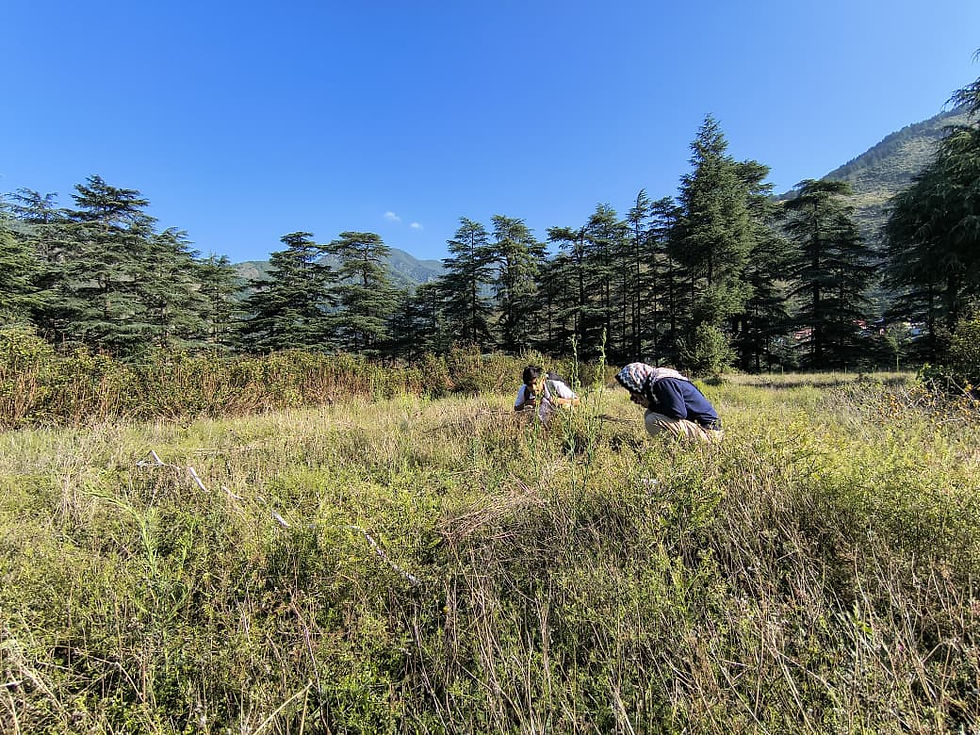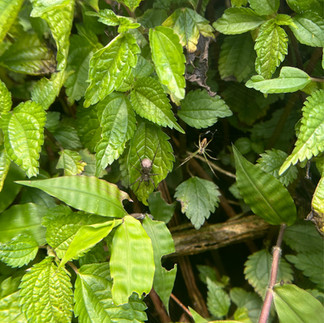Looking for Spiders in the Montane Forests of Devalsari
- Sneha Khati and Lalit Mohan Bhatt
- Sep 8
- 4 min read
Updated: Sep 11
When you think of mountain forests in Uttarakhand, you may picture majestic trees, beautiful birds and colourful butterflies, but would you think of spiders? That’s exactly what we focused on during our recent field trip to Devalsari, a small hamlet hidden away in the Tehri Garhwal.

Devalsari is home to incredible biodiversity – with over 175 species of birds and more than 200 species of butterflies and moths recorded here. What is even more remarkable is the commitment of the local community to safeguarding this biodiversity richness from threats such as unchecked deforestation. Each person we met here had a personal story connecting them to their land. Devalsari has become a popular destination for butterfly enthusiasts; every year, the community organises a ‘Titli Utsav’ (Butterfly Festival) which attracts participants from all over India. The hamlet is also popular among birding enthusiasts.

We spent the first week of June in Devalsari for the field ecology component of our ecology course at the Lodha Genius Programme. During this field trip, each of us was asked to choose a project that looked at the ecology of this beautiful landscape. What stood out for the two of us was the number of spiders we were seeing everywhere. It surprised us to learn that the butterflies and birds of this space had received so much attention, but nobody had noticed the spiders. So, we decided to focus our project on getting a glimpse of Devalsari’s spiders, with the guidance of our professor, Samuel John, who specialises in studying them. Our motivation was to highlight these smaller, lesser-known creatures that play a vital role in Devalsari’s ecosystems. Globally, spiders are estimated to consume roughly 400-800 million tonnes of prey each year, most of it insects. They are important predators who keep insect populations in balance across forests, grasslands, and agricultural lands.

Based on our observations from the first two days of walking through the forests, streams, and agricultural fields, we began with the hypothesis that there were at least 50 different species of spiders across these habitats. To test this, we marked out two small 3m x 3m square plots in each habitat, ensuring that they were at least 50 metres apart, and spent an hour looking for spiders within each plot. Although we had only three days to complete our data collection, we managed to find 50 different morphospecies (individuals distinguished by external appearance) of spiders. We observed spiders weaving webs, as well as those that do not build webs, running along the ground. There are over 52,000 known species of spiders in the world, and each species has a unique lifestyle adapted to its environment. We even learned that spiders can be identified by the type of web they build - orb webs, tent webs, 3-D tangle webs, and more!

We also took notes on their behaviours. Just by watching each individual for 3-5 minutes, we saw spiders plucking the silk of their webs (a behaviour we called ‘guitaring’), and using cryptic postures to camouflage themselves from predators. We also witnessed some behaviours we hadn't expected - spiders sitting by the edge of streams waiting to catch fish, fierce stand-offs between competing males, and ballooning, where spiders release silk threads that allow them to fly through the air. We also noticed that spiders used different strategies to catch their prey: some waited in one place to ambush, while others actively chased their prey. In the end, we categorized all the spiders we had seen based on the behaviors they exhibited.
Aside from the 4-5 hours of daily surveying, we spent the rest of our time collating data or attending sessions with our professors. This also meant we did not get a chance to survey the diversity of spiders at night. Nocturnal spiders are a completely different group and would likely have added at least another 50 morphospecies to our list.

Based on the data we collected, we created a simple morphospecies accumulation graph, which showed that we would continue to encounter new species if we kept surveying spiders in Devalsari. If we add night-time surveys to this, the spider diversity of Devalsari is likely to at least be a few hundred different types of spiders! Exploring the forests, streams and farms from this new perspective of spiders was an extremely rewarding experience, and we hope that more attention is given to the spiders of Devalsari in the future. Perhaps a ‘Makdi Utsav’ (Spider Festival) should be added to Devalsari’s biodiversity calendar.

Spiders seen during the surveys. Photos by Sneha Khati
About the authors
Sneha is from Uttarakhand and loves observing nature and its beauty. She also enjoys interacting with new people and learning new things.
Lalit is also from Uttarakhand and is passionate about sports and spending time outdoors. He also enjoys interacting with small insects and animals.
Sneha and Lalit conducted their study during their field ecology course at the Lodha Genius Programme hosted at Ashoka University.
















Comments